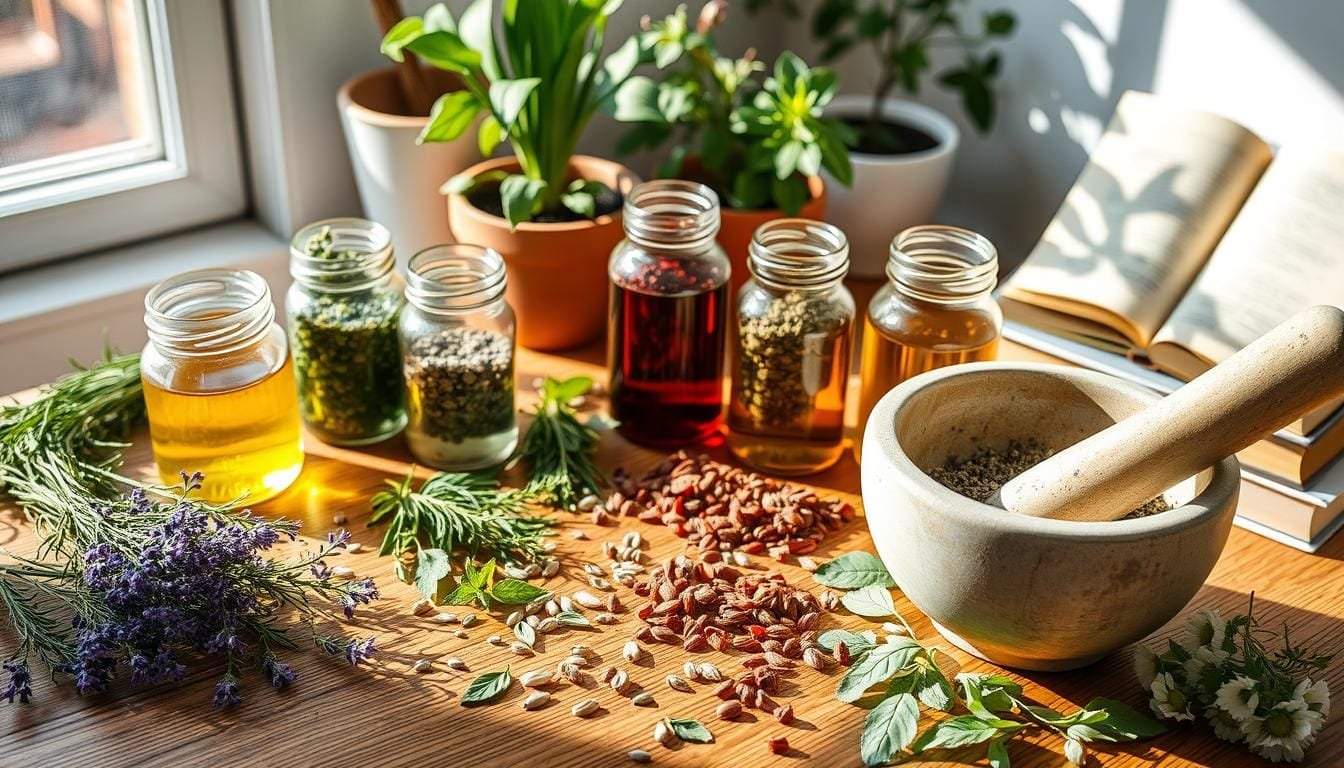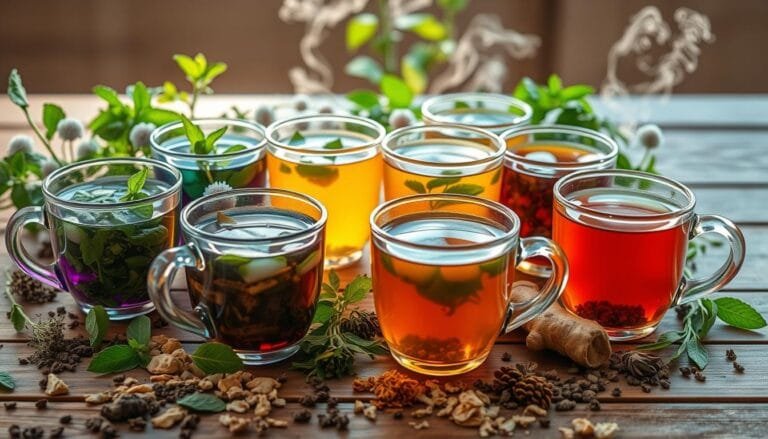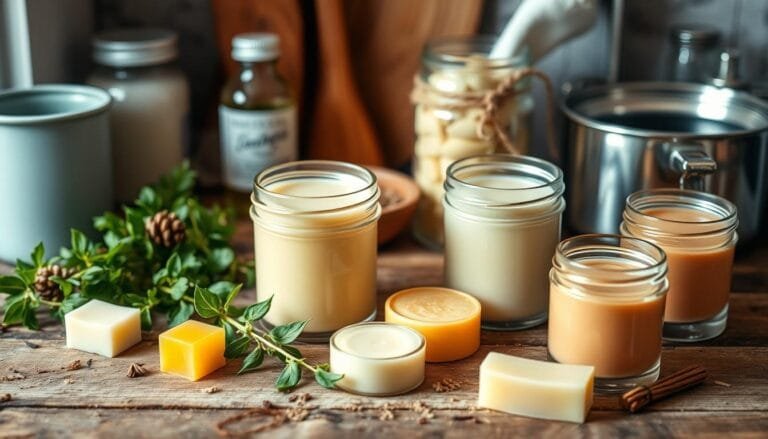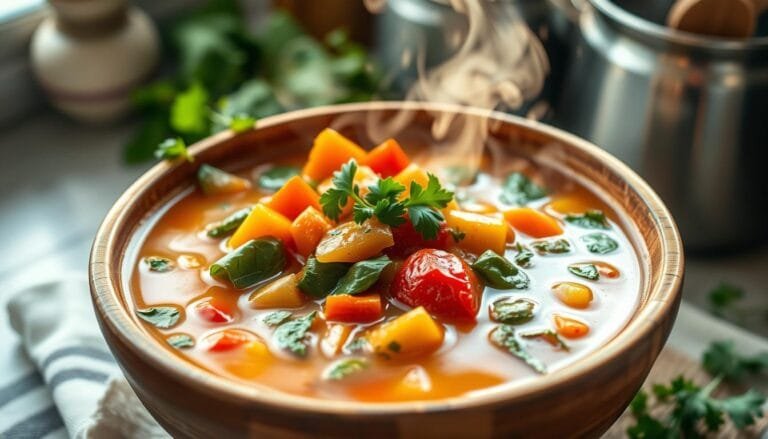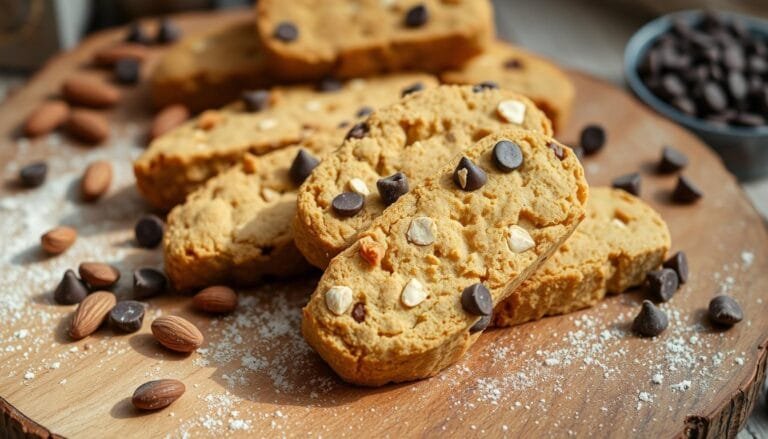I’m passionate about natural remedies, and homemade herbal oil blends are amazing. They’re soothing, therapeutic, and promote well-being. By mixing oils with herbs, we get concentrated remedies for skin care and cooking.
Making herbal oil blends is a tradition that goes back centuries. The solar infusion method works well in summer. It lets herbs slowly add their good stuff to the oil. These oils are safer for kids and those with sensitive skin because they’re less strong than essential oils.
Want to make a calming lavender blend, a citrus energizer, or something to help your breathing? The options are endless for making your own herbal infusions. Using plants, we can make personal remedies that meet our needs. It’s all about supporting our wellness and healing journey.
Understanding the Power of Herbal-Infused Oils
Herbal-infused oils have been around for thousands of years. They use plants to heal and improve skin. Unlike essential oils, they take material from the whole plant, not just the scent. This makes them safe to use straight on the skin, giving a complete approach to health and beauty.
Traditional Uses Throughout History
Herbal-infused oils have a long history, starting with ancient Egyptians. They used them for skin care. Many cultures have valued these natural remedies, showing their lasting appeal.
Benefits of Natural Plant-Based Solutions
Herbal-infused oils have many benefits. They moisturize, soothe, heal, and more. They use herbs to meet different skin and health needs.
Difference Between Essential and Infused Oils
Essential oils are made by distillation and are strong and fragrant. Herbal infusions, on the other hand, take material from the whole plant. This makes them safe to use without diluting, providing a complete way to care for your skin and health.
| Characteristic | Essential Oils | Herbal-Infused Oils |
|---|---|---|
| Extraction Method | Distillation | Infusion |
| Concentration | Highly concentrated | Less concentrated |
| Fragrance | Highly fragrant | Mild fragrance |
| Dilution | Requires dilution | Can be used undiluted |
| Holistic Approach | Focused on aromatic components | Utilizes the whole plant |
Knowing the difference between essential and infused oils helps you choose the right natural remedies. This way, you can add them to your wellness and beauty routines wisely.
Essential Components for Creating Herbal Oil Blends
Making your own herbal oil blends is a fun and natural way to use plants’ healing powers. You’ll need good carrier oils, a variety of dried herbs, clean glass jars, and the right straining materials.
The base of your blend is the carrier oil. Olive, jojoba, and almond oils are great because they’re good for your skin and last a long time. The herbs you choose will depend on what health benefits you want. Herbs like arnica, lavender, chamomile, and peppermint have different healing powers.
For storing and infusing your herbs in oil, use glass jars with tight lids. Tools like cheesecloth, fine-mesh strainers, or nut milk bags help filter the oil. This makes sure your blend is clear and free from impurities.
It’s important to use dried herbs, not fresh ones. Dried herbs have less moisture, which helps prevent mold and keeps the oil fresh longer. The slow, cold infusion method is best. It lets the herbs slowly add their good stuff to the oil, keeping its healing powers strong.
| Key Component | Recommendation |
|---|---|
| Carrier Oils | Olive, jojoba, almond |
| Dried Herbs | Arnica, lavender, chamomile, peppermint |
| Glass Jars | With tight-fitting lids |
| Straining Materials | Cheesecloth, fine-mesh strainer, nut milk bag |
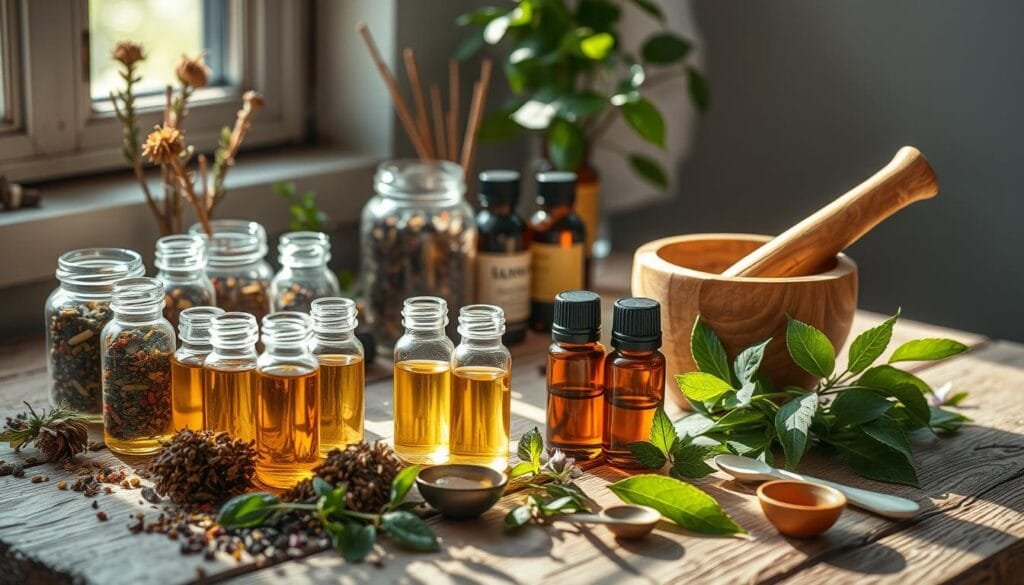
“The slow, cold infusion method is often preferred, as it allows the herbs to gradually release their beneficial compounds into the oil, preserving their therapeutic properties.”
Selecting the Right Carrier Oils for Your Blends
Choosing the right carrier oil is key when making homemade herbal oil blends. Carrier oils like olive oil, jojoba oil, almond oil, avocado oil, sunflower oil, and coconut oil each have special benefits. Knowing what each oil offers helps you pick the best one for your needs.
Popular Carrier Oil Options
- Fractionated Coconut Oil: It’s light, lasts long, and has no smell, perfect for mixing with essential oils.
- Grapeseed Oil: It’s full of linoleic acid, not greasy, and packed with Vitamin C, great for skin health.
- Jojoba Oil: It’s like the skin’s natural oil, balancing it well for all skin types.
- Sweet Almond Oil: It’s gentle, fights inflammation, and has a softening effect on the skin.
- Apricot Kernel Oil: It’s good for aging skin, deeply moisturizes, and absorbs quickly.
Understanding Oil Properties and Benefits
Each carrier oil has its own special traits and benefits. Olive oil has a strong smell and thick texture. Avocado oil has a short shelf life and a strong scent. Coconut oil can turn solid at room temperature, making it hard to use in roller bottles. Knowing these differences helps you make blends that meet your needs.
Storage and Shelf Life Considerations
Keeping carrier oils in cool, dark places is important. Store them in the fridge and use dark glass bottles to prevent damage. Some oils, like grapeseed oil and jojoba oil, last longer than others, like avocado oil. Taking care of these details keeps your blends fresh and effective.
| Carrier Oil | Characteristics | Benefits |
|---|---|---|
| Fractionated Coconut Oil | Lightweight, long shelf life, odorless | Ideal for blending with essential oils |
| Grapeseed Oil | High in linoleic acid, non-greasy, rich in Vitamin C | Nourishing for the skin |
| Jojoba Oil | Closely resembles skin’s sebum, balances oil production | Suitable for all skin types |
| Sweet Almond Oil | Gentle, anti-inflammatory, antibacterial, light aroma | Softens skin |
| Apricot Kernel Oil | Anti-aging benefits, deep moisturization, quick absorption | Subtle scent |
Therapeutic Properties of Common Healing Herbs
Herbal oils are more than just fragrant. They have many health benefits because of the special compounds in plants. Calendula, chamomile, lavender, comfrey, plantain, and St. John’s Wort are some of the most used herbs. Each one adds unique benefits to homemade oil blends.
Calendula is great for soothing and caring for the skin. Chamomile helps reduce inflammation and soothe irritation. Lavender is good for relaxation, healing wounds, and keeping the skin healthy.
Comfrey helps repair cells, and plantain moisturizes and heals the skin. St. John’s Wort is known for its calming effects on the skin.
By mixing these herbs in your homemade oils, you can make strong natural remedies. These can help improve your health and well-being.
| Herb | Key Therapeutic Properties |
|---|---|
| Calendula | Skin soothing, nourishing |
| Chamomile | Anti-inflammatory, relaxing |
| Lavender | Skin healing, relaxation |
| Comfrey | Cell regenerative |
| Plantain | Emollient, healing |
| St. John’s Wort | Skin soothing |
Using these herbs in your homemade oils lets you make natural remedies that fit your needs.

“Herbal oils are a wonderful way to harness the power of nature and support your overall well-being.”
The Solar Infusion Method: A Traditional Approach
The solar infusion method is a traditional way to make potent oils. It uses the sun’s warmth to extract good stuff from herbs. You put dried herbs and oil in a jar, then leave it in the sun for a while.
Step-by-Step Solar Infusion Process
- Choose your desired dried herbs and high-quality carrier oils, such as olive, almond, or jojoba oil.
- Place the herbs and oils in a clean, sterilized glass jar, making sure the herbs are fully submerged in the oil.
- Seal the jar tightly and place it in a sunny spot, such as a windowsill or patio, during the warmest months of the year.
- Allow the jar to steep for 2-4 weeks, bringing it indoors at night and returning it to the sun during the day.
- Once the infusion period is complete, strain the oil through a fine-mesh strainer or cheesecloth to remove the herbs.
- Store the strained, sun-infused oil in a dark, cool place for long-lasting freshness and potency.
Best Seasons for Solar Infusion
The best time for solar infusion is in the summer, like July or August. The sun is strong, and the temperatures are warm. This makes the infusion process faster and more effective.
The solar infusion method is a natural way to make strong oils. It uses the sun’s power to extract good stuff from herbs. With patience and the right weather, you can make your own sun-infused oils, natural extraction, and summer herb infusion.
Quick Methods for Making Homemade Herbal Oil Blends
There are faster ways to make herbal oil blends at home. These methods let you make fragrant, strong herbal oils in hours, not weeks.
Slow Cooker Infusion
The slow cooker infusion method is easy and doesn’t require much effort. Just put your jars of herbs and oil in a slow cooker with water. Set it to “warm” and let it infuse for 8-24 hours. Make sure the oil doesn’t get too hot.
Double Boiler Technique
The double boiler method uses a setup with two pots. Simmer water in the bottom pot and place your herb and oil mixture in the top. Let it infuse for 3-4 hours, stirring now and then. This method makes flavorful oils faster than solar infusion.
These quick methods are handy but might not get as many benefits as solar infusion. Use them for everyday needs and save solar-infused oils for special uses.
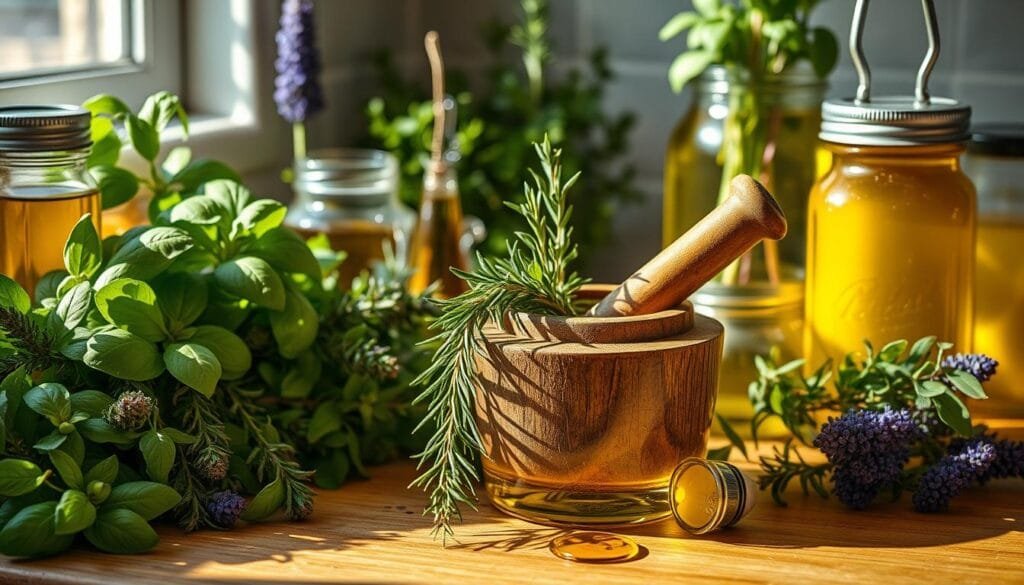
“Herbal oils infused using the Sun Method are generally left to infuse for 4 to 6 weeks, with the option of double infusing for certain oils like calendula. Heat Infusion Method yields a quicker result, infusing for 2 hours continuously.”
Choosing a quick method means watching the temperature and time closely. With practice, you can make strong, scented herbal oils for your wellness and beauty routines.
Safety Guidelines and Best Practices
When using essential oils and herbal-infused oils, safety comes first. It’s important to dilute and store them correctly. This ensures their safe and effective use. Here are the essential guidelines to remember.
Proper Dilution Ratios
Always dilute essential oils before applying them to your skin. The usual dilution ratio is 1-2% essential oil in a carrier oil. For sensitive skin or kids, start with 0.5-1% dilution. This helps avoid skin irritation and boosts the oils’ benefits.
Storage Requirements
Store herbal-infused oils in dark glass bottles, away from light and heat. This keeps the oil’s quality and strength. Store them in a cool, dark spot, like a cabinet or pantry. This way, herbal oils can last up to a year, though some may not last as long.
Contraindications and Precautions
Before using any herb or essential oil, check if it’s safe for you. This is very important for people with sensitive skin, pregnant women, and kids. Some oils and herbs can interact with medicines or have specific warnings. Always talk to a healthcare professional, like a doctor, before using essential oils on kids or during pregnancy.
By following these safety tips and best practices, you can enjoy homemade herbal-infused oils safely. Remember, essential oil safety and responsible usage are key when making and using these natural remedies.

Popular Herbal Oil Combinations for Wellness
Herbal oil blends are a powerful way to use nature for wellness. These blends mix healing aromatherapy oils for many benefits. They can ease muscle pain and help with emotional balance.
An arnica-based blend is a favorite for many. It’s made by mixing arnica with a carrier oil. This blend helps with bruises, sprains, and muscle aches.
Another favorite is a calming mix of calendula, plantain, and rosemary. It’s great for skin issues and helps hair grow well.
| Blend | Key Ingredients | Benefits |
|---|---|---|
| Calming Lavender Dreams | Lavender, Roman Chamomile, Bergamot, Oregano | Promotes relaxation and restful sleep |
| Citrus Burst Energizer | Sweet Orange, Lemon, Grapefruit, Basil | Uplifts mood and boosts energy |
| Breathe Easy Respiratory Blend | Eucalyptus, Peppermint, Tea Tree, Lemon | Supports clear breathing and respiratory health |
For a blend that does it all, try mixing echinacea, comfrey, plantain, calendula, rosemary, and yarrow. This mix tackles many issues, from skin problems to minor injuries.
“The power of nature lies in the synergy of its elements. By blending thoughtfully selected healing herbs and aromatherapy oils, we can create truly transformative therapeutic combinations for holistic wellness.”
Creating Custom Blends for Specific Needs
Herbal-infused oils offer endless possibilities. You can mix targeted herbal remedies and customize oil blends for your wellness needs. Whether it’s for skin care, muscle support, or breathing, the right mix can be transformative.
Skin Care Formulations
For skin care, use herbs like calendula, chamomile, and plantain. They soothe, hydrate, and enhance your glow. Mix them with jojoba or argan oil for a luxurious blend.
Muscle and Joint Support
Herbs like arnica, St. John’s Wort, and rosemary support muscles and joints. Blend them with coconut or sweet almond oil for a restorative formula.
Respiratory Support Blends
Herbs like eucalyptus, peppermint, and thyme are great for breathing. They soothe, clear airways, and ease breathing. Use fractionated coconut or grapeseed oil for a soothing blend.
Always research the herbs you use in custom blends. Safety and proper dilution are key. With care and experimentation, you can create remedies for your specific needs.
Quality Control and Ingredient Sourcing
Creating homemade herbal oil blends is a passion for me. Quality control is key. I get my organic dried herbs from trusted suppliers who use sustainable methods. I choose only the freshest herbs to ensure my blends are safe and effective.
Choosing carrier oils is also important to me. I look for cold-pressed, unrefined oils for their strong scent and health benefits. Sometimes, I pick naturally refined oils for a milder smell. Expeller-pressed oils are great for skin and hair care.
| Oil Type | Extraction Method | Key Characteristics |
|---|---|---|
| Cold-Pressed | Mechanical extraction at controlled temperatures | Maintains natural state and beneficial constituents |
| Expeller-Pressed | Mechanical extraction using hydraulic presses | Stable oils suitable for body and hair care |
| Solvent-Extracted | Washed with volatile hydrocarbon solvents | Potential environmental and health concerns |
| Unrefined | Mechanically extracted and lightly filtered | Retains beneficial constituents, natural colors, and scents |
| Naturally Refined | Gentle processing methods like steam-distillation | Stabilizes and removes impurities while retaining natural constituents |
| Conventionally Refined | Processed using chemical solvents and high heat | Strips beneficial constituents, less ideal for natural formulations |
I follow the FDA’s Current Good Manufacturing Practices (cGMPs) for quality. This means I invest in training and detailed procedures. It’s a big commitment, but it’s necessary for selling organic herbs and other herbal products in the U.S.
By choosing sustainable harvesting materials from reputable suppliers and sticking to quality control, I can make herbal oil blends that are safe and effective. My customers get the natural wellness benefits they’re looking for.
Applications and Usage Methods for Herbal Oil Blends
I love using homemade herbal oil blends for natural wellness. They are versatile and can be used in many ways. We can use them for topical application, aromatherapy, and even cleaning.
One of my top uses is in massage. The oils help relax muscles and reduce tension. They also promote calmness. I also make DIY salves and lotions with these oils, making skincare personal.
Herbal oil blends are great for aromatherapy too. They can be diffused or applied to the skin. This helps our emotional and physical health. For example, lavender calms us, while rosemary clears the mind.
But did you know you can use them for cleaning? They have antimicrobial and deodorizing properties. This lets me make eco-friendly cleaners that are safe for our homes.
